Business Law: Misrepresentation and Negligence
VerifiedAdded on 2023/06/11
|9
|2316
|259
AI Summary
This article discusses misrepresentation and negligence in business law with two solved case scenarios. It explains the rules, tests, and exceptions related to misrepresentation and negligence. The first case scenario deals with misrepresentation of facts by Jessica to Angela, and the second case scenario deals with negligence by Acme Cola Manufacturing Company towards Sandra Smith. The article also cites relevant case laws and statutes.
Contribute Materials
Your contribution can guide someone’s learning journey. Share your
documents today.
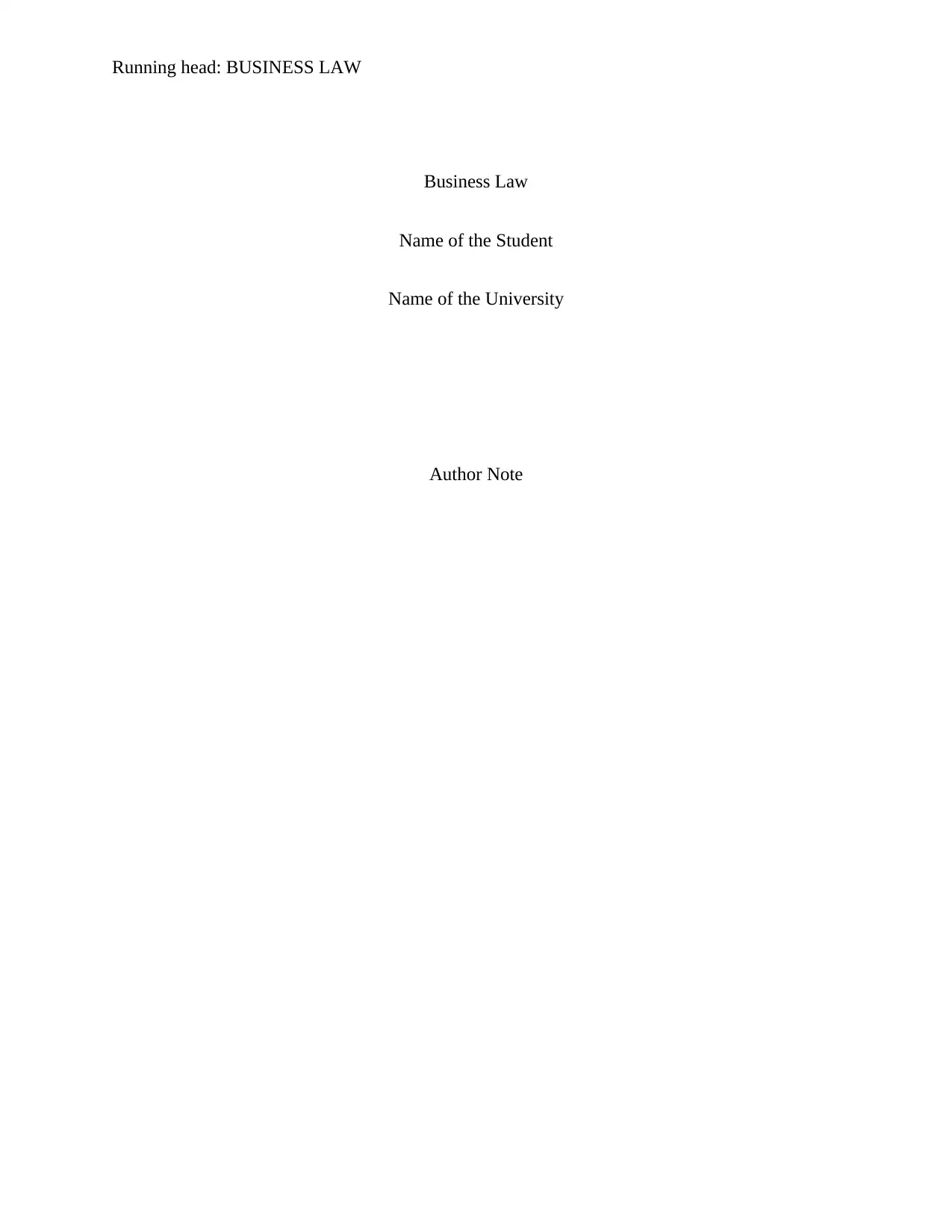
Running head: BUSINESS LAW
Business Law
Name of the Student
Name of the University
Author Note
Business Law
Name of the Student
Name of the University
Author Note
Secure Best Marks with AI Grader
Need help grading? Try our AI Grader for instant feedback on your assignments.
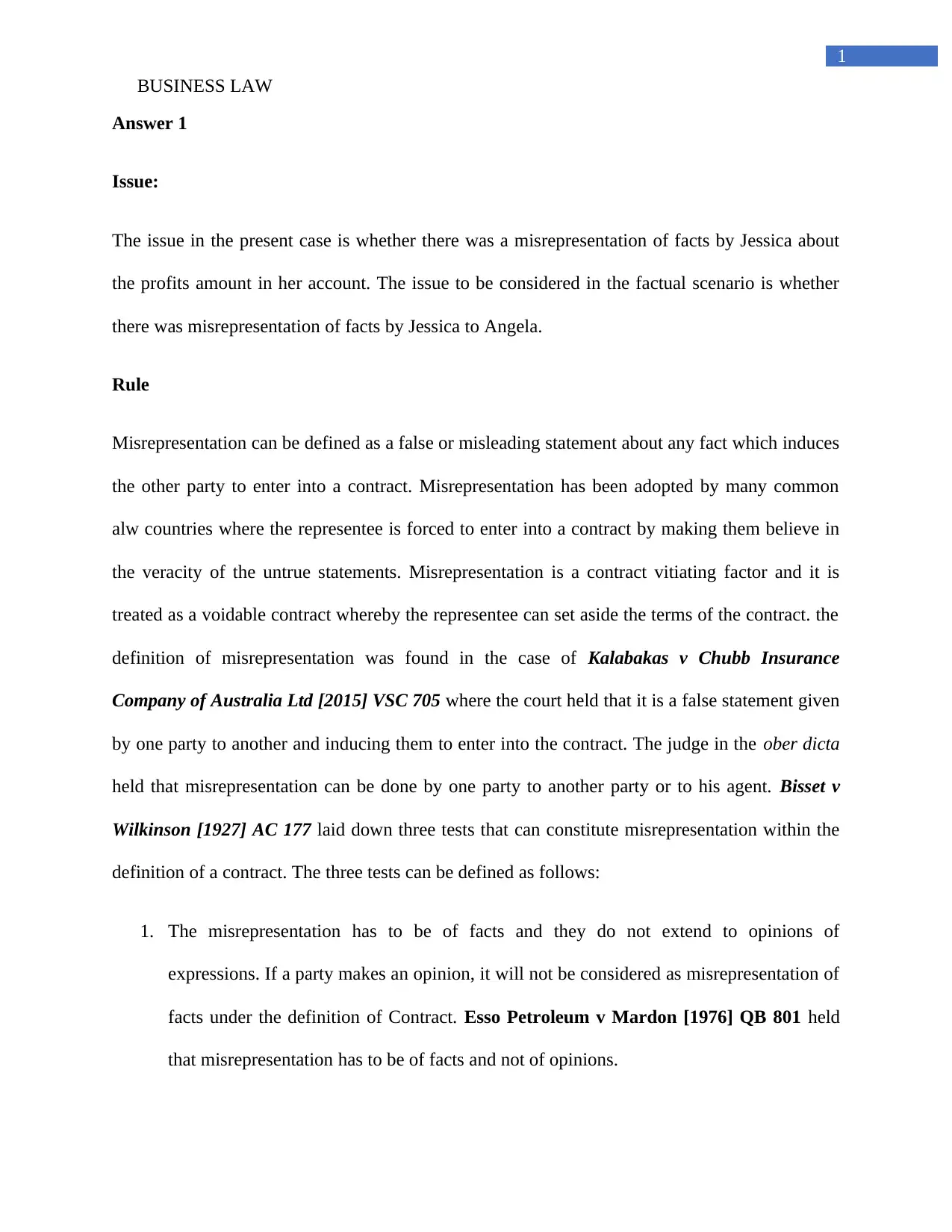
1
BUSINESS LAW
Answer 1
Issue:
The issue in the present case is whether there was a misrepresentation of facts by Jessica about
the profits amount in her account. The issue to be considered in the factual scenario is whether
there was misrepresentation of facts by Jessica to Angela.
Rule
Misrepresentation can be defined as a false or misleading statement about any fact which induces
the other party to enter into a contract. Misrepresentation has been adopted by many common
alw countries where the representee is forced to enter into a contract by making them believe in
the veracity of the untrue statements. Misrepresentation is a contract vitiating factor and it is
treated as a voidable contract whereby the representee can set aside the terms of the contract. the
definition of misrepresentation was found in the case of Kalabakas v Chubb Insurance
Company of Australia Ltd [2015] VSC 705 where the court held that it is a false statement given
by one party to another and inducing them to enter into the contract. The judge in the ober dicta
held that misrepresentation can be done by one party to another party or to his agent. Bisset v
Wilkinson [1927] AC 177 laid down three tests that can constitute misrepresentation within the
definition of a contract. The three tests can be defined as follows:
1. The misrepresentation has to be of facts and they do not extend to opinions of
expressions. If a party makes an opinion, it will not be considered as misrepresentation of
facts under the definition of Contract. Esso Petroleum v Mardon [1976] QB 801 held
that misrepresentation has to be of facts and not of opinions.
BUSINESS LAW
Answer 1
Issue:
The issue in the present case is whether there was a misrepresentation of facts by Jessica about
the profits amount in her account. The issue to be considered in the factual scenario is whether
there was misrepresentation of facts by Jessica to Angela.
Rule
Misrepresentation can be defined as a false or misleading statement about any fact which induces
the other party to enter into a contract. Misrepresentation has been adopted by many common
alw countries where the representee is forced to enter into a contract by making them believe in
the veracity of the untrue statements. Misrepresentation is a contract vitiating factor and it is
treated as a voidable contract whereby the representee can set aside the terms of the contract. the
definition of misrepresentation was found in the case of Kalabakas v Chubb Insurance
Company of Australia Ltd [2015] VSC 705 where the court held that it is a false statement given
by one party to another and inducing them to enter into the contract. The judge in the ober dicta
held that misrepresentation can be done by one party to another party or to his agent. Bisset v
Wilkinson [1927] AC 177 laid down three tests that can constitute misrepresentation within the
definition of a contract. The three tests can be defined as follows:
1. The misrepresentation has to be of facts and they do not extend to opinions of
expressions. If a party makes an opinion, it will not be considered as misrepresentation of
facts under the definition of Contract. Esso Petroleum v Mardon [1976] QB 801 held
that misrepresentation has to be of facts and not of opinions.
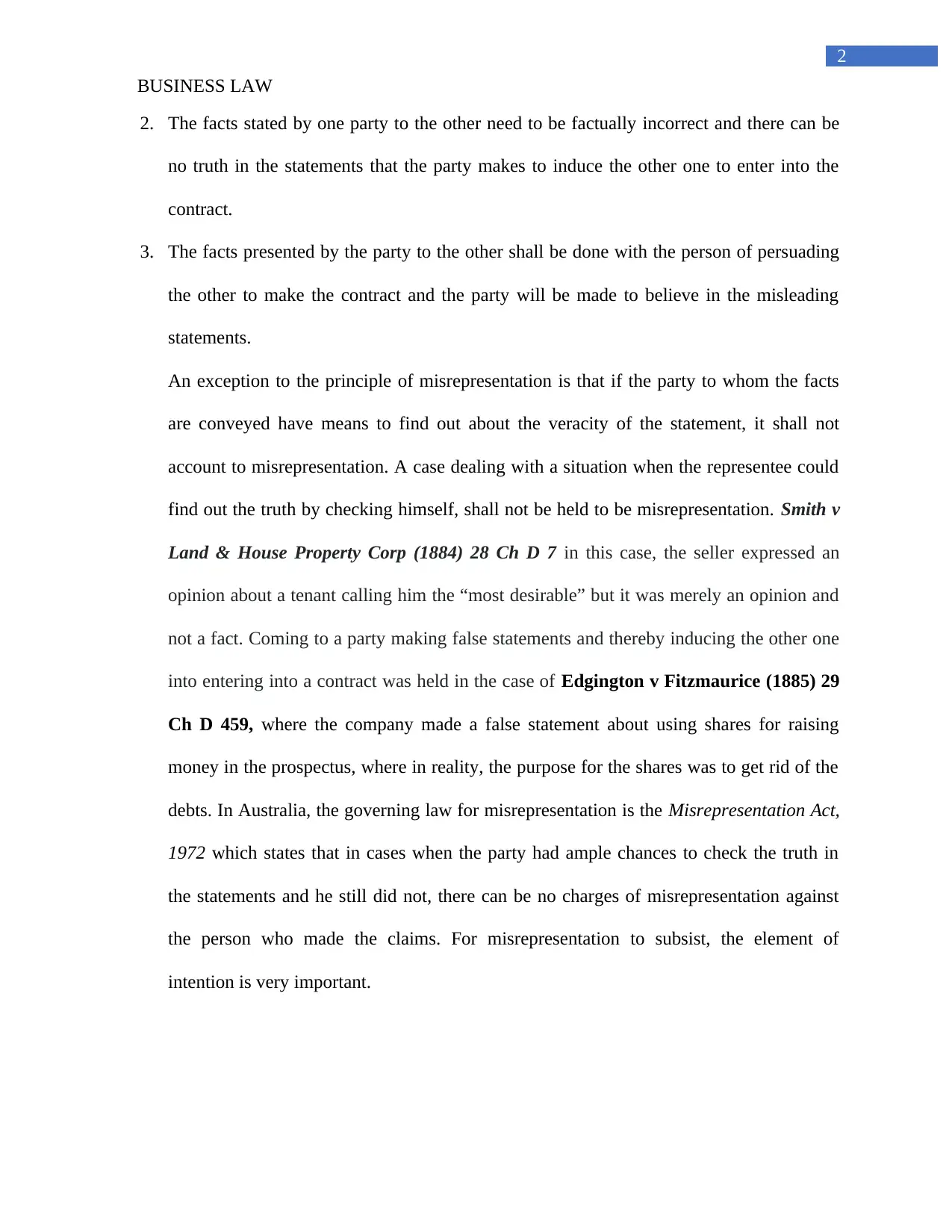
2
BUSINESS LAW
2. The facts stated by one party to the other need to be factually incorrect and there can be
no truth in the statements that the party makes to induce the other one to enter into the
contract.
3. The facts presented by the party to the other shall be done with the person of persuading
the other to make the contract and the party will be made to believe in the misleading
statements.
An exception to the principle of misrepresentation is that if the party to whom the facts
are conveyed have means to find out about the veracity of the statement, it shall not
account to misrepresentation. A case dealing with a situation when the representee could
find out the truth by checking himself, shall not be held to be misrepresentation. Smith v
Land & House Property Corp (1884) 28 Ch D 7 in this case, the seller expressed an
opinion about a tenant calling him the “most desirable” but it was merely an opinion and
not a fact. Coming to a party making false statements and thereby inducing the other one
into entering into a contract was held in the case of Edgington v Fitzmaurice (1885) 29
Ch D 459, where the company made a false statement about using shares for raising
money in the prospectus, where in reality, the purpose for the shares was to get rid of the
debts. In Australia, the governing law for misrepresentation is the Misrepresentation Act,
1972 which states that in cases when the party had ample chances to check the truth in
the statements and he still did not, there can be no charges of misrepresentation against
the person who made the claims. For misrepresentation to subsist, the element of
intention is very important.
BUSINESS LAW
2. The facts stated by one party to the other need to be factually incorrect and there can be
no truth in the statements that the party makes to induce the other one to enter into the
contract.
3. The facts presented by the party to the other shall be done with the person of persuading
the other to make the contract and the party will be made to believe in the misleading
statements.
An exception to the principle of misrepresentation is that if the party to whom the facts
are conveyed have means to find out about the veracity of the statement, it shall not
account to misrepresentation. A case dealing with a situation when the representee could
find out the truth by checking himself, shall not be held to be misrepresentation. Smith v
Land & House Property Corp (1884) 28 Ch D 7 in this case, the seller expressed an
opinion about a tenant calling him the “most desirable” but it was merely an opinion and
not a fact. Coming to a party making false statements and thereby inducing the other one
into entering into a contract was held in the case of Edgington v Fitzmaurice (1885) 29
Ch D 459, where the company made a false statement about using shares for raising
money in the prospectus, where in reality, the purpose for the shares was to get rid of the
debts. In Australia, the governing law for misrepresentation is the Misrepresentation Act,
1972 which states that in cases when the party had ample chances to check the truth in
the statements and he still did not, there can be no charges of misrepresentation against
the person who made the claims. For misrepresentation to subsist, the element of
intention is very important.
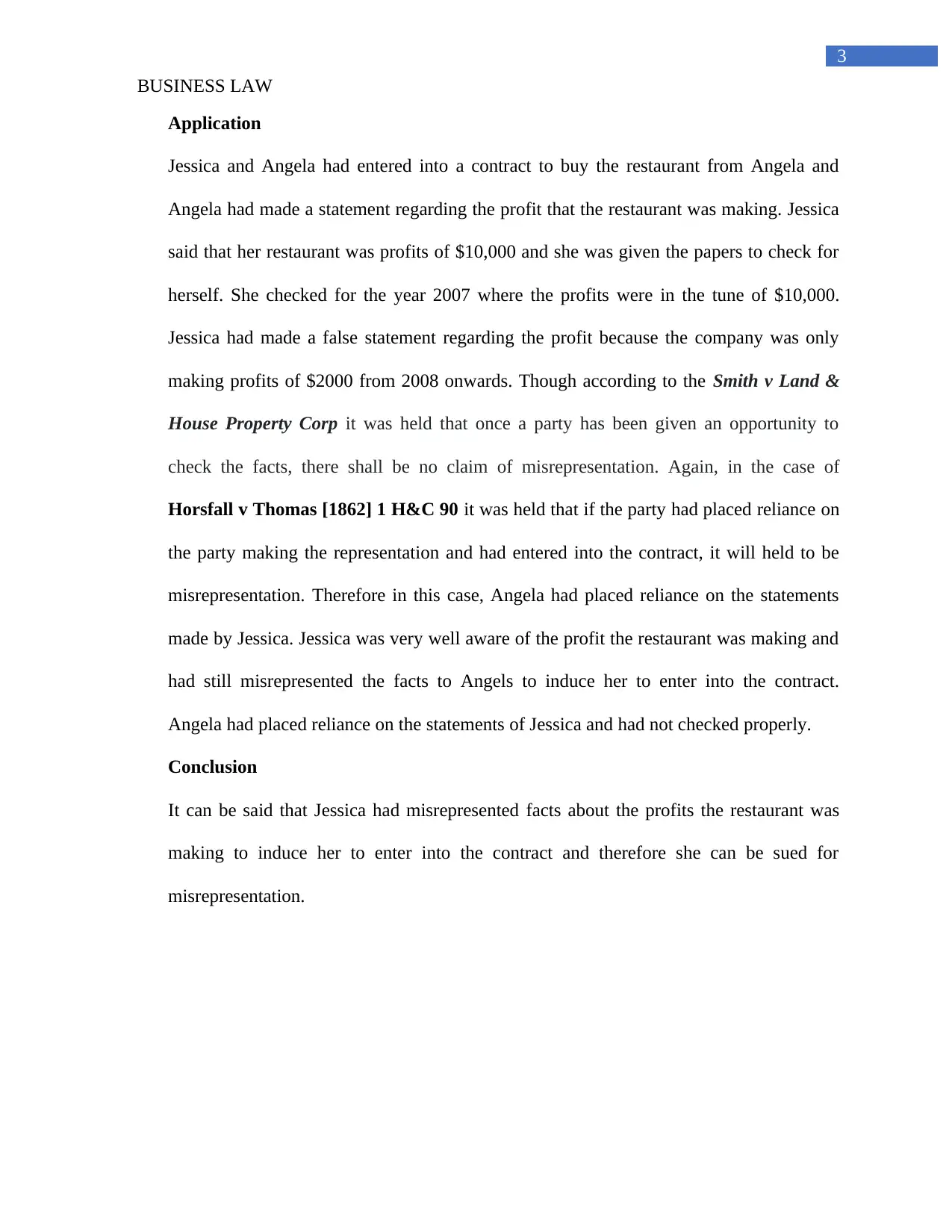
3
BUSINESS LAW
Application
Jessica and Angela had entered into a contract to buy the restaurant from Angela and
Angela had made a statement regarding the profit that the restaurant was making. Jessica
said that her restaurant was profits of $10,000 and she was given the papers to check for
herself. She checked for the year 2007 where the profits were in the tune of $10,000.
Jessica had made a false statement regarding the profit because the company was only
making profits of $2000 from 2008 onwards. Though according to the Smith v Land &
House Property Corp it was held that once a party has been given an opportunity to
check the facts, there shall be no claim of misrepresentation. Again, in the case of
Horsfall v Thomas [1862] 1 H&C 90 it was held that if the party had placed reliance on
the party making the representation and had entered into the contract, it will held to be
misrepresentation. Therefore in this case, Angela had placed reliance on the statements
made by Jessica. Jessica was very well aware of the profit the restaurant was making and
had still misrepresented the facts to Angels to induce her to enter into the contract.
Angela had placed reliance on the statements of Jessica and had not checked properly.
Conclusion
It can be said that Jessica had misrepresented facts about the profits the restaurant was
making to induce her to enter into the contract and therefore she can be sued for
misrepresentation.
BUSINESS LAW
Application
Jessica and Angela had entered into a contract to buy the restaurant from Angela and
Angela had made a statement regarding the profit that the restaurant was making. Jessica
said that her restaurant was profits of $10,000 and she was given the papers to check for
herself. She checked for the year 2007 where the profits were in the tune of $10,000.
Jessica had made a false statement regarding the profit because the company was only
making profits of $2000 from 2008 onwards. Though according to the Smith v Land &
House Property Corp it was held that once a party has been given an opportunity to
check the facts, there shall be no claim of misrepresentation. Again, in the case of
Horsfall v Thomas [1862] 1 H&C 90 it was held that if the party had placed reliance on
the party making the representation and had entered into the contract, it will held to be
misrepresentation. Therefore in this case, Angela had placed reliance on the statements
made by Jessica. Jessica was very well aware of the profit the restaurant was making and
had still misrepresented the facts to Angels to induce her to enter into the contract.
Angela had placed reliance on the statements of Jessica and had not checked properly.
Conclusion
It can be said that Jessica had misrepresented facts about the profits the restaurant was
making to induce her to enter into the contract and therefore she can be sued for
misrepresentation.
Secure Best Marks with AI Grader
Need help grading? Try our AI Grader for instant feedback on your assignments.
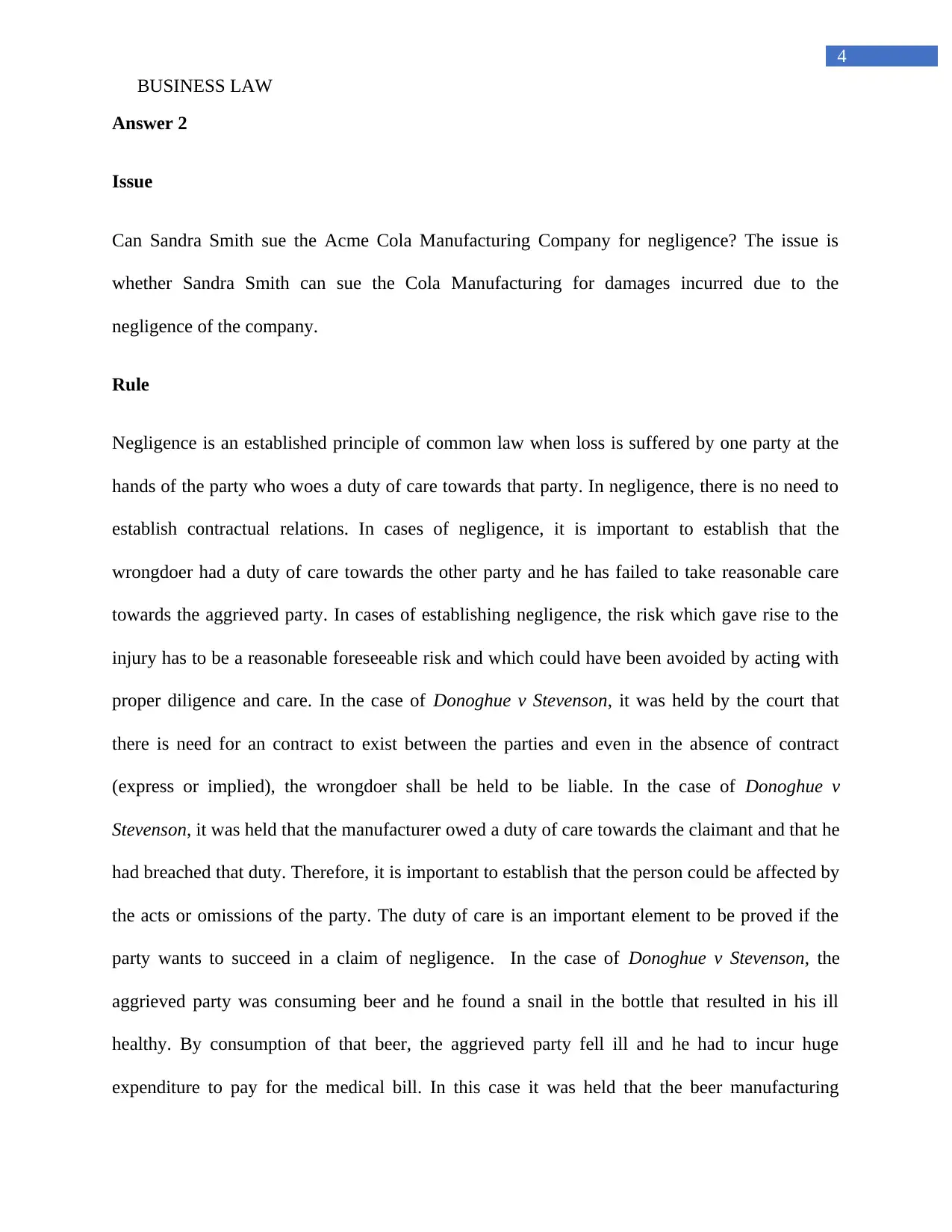
4
BUSINESS LAW
Answer 2
Issue
Can Sandra Smith sue the Acme Cola Manufacturing Company for negligence? The issue is
whether Sandra Smith can sue the Cola Manufacturing for damages incurred due to the
negligence of the company.
Rule
Negligence is an established principle of common law when loss is suffered by one party at the
hands of the party who woes a duty of care towards that party. In negligence, there is no need to
establish contractual relations. In cases of negligence, it is important to establish that the
wrongdoer had a duty of care towards the other party and he has failed to take reasonable care
towards the aggrieved party. In cases of establishing negligence, the risk which gave rise to the
injury has to be a reasonable foreseeable risk and which could have been avoided by acting with
proper diligence and care. In the case of Donoghue v Stevenson, it was held by the court that
there is need for an contract to exist between the parties and even in the absence of contract
(express or implied), the wrongdoer shall be held to be liable. In the case of Donoghue v
Stevenson, it was held that the manufacturer owed a duty of care towards the claimant and that he
had breached that duty. Therefore, it is important to establish that the person could be affected by
the acts or omissions of the party. The duty of care is an important element to be proved if the
party wants to succeed in a claim of negligence. In the case of Donoghue v Stevenson, the
aggrieved party was consuming beer and he found a snail in the bottle that resulted in his ill
healthy. By consumption of that beer, the aggrieved party fell ill and he had to incur huge
expenditure to pay for the medical bill. In this case it was held that the beer manufacturing
BUSINESS LAW
Answer 2
Issue
Can Sandra Smith sue the Acme Cola Manufacturing Company for negligence? The issue is
whether Sandra Smith can sue the Cola Manufacturing for damages incurred due to the
negligence of the company.
Rule
Negligence is an established principle of common law when loss is suffered by one party at the
hands of the party who woes a duty of care towards that party. In negligence, there is no need to
establish contractual relations. In cases of negligence, it is important to establish that the
wrongdoer had a duty of care towards the other party and he has failed to take reasonable care
towards the aggrieved party. In cases of establishing negligence, the risk which gave rise to the
injury has to be a reasonable foreseeable risk and which could have been avoided by acting with
proper diligence and care. In the case of Donoghue v Stevenson, it was held by the court that
there is need for an contract to exist between the parties and even in the absence of contract
(express or implied), the wrongdoer shall be held to be liable. In the case of Donoghue v
Stevenson, it was held that the manufacturer owed a duty of care towards the claimant and that he
had breached that duty. Therefore, it is important to establish that the person could be affected by
the acts or omissions of the party. The duty of care is an important element to be proved if the
party wants to succeed in a claim of negligence. In the case of Donoghue v Stevenson, the
aggrieved party was consuming beer and he found a snail in the bottle that resulted in his ill
healthy. By consumption of that beer, the aggrieved party fell ill and he had to incur huge
expenditure to pay for the medical bill. In this case it was held that the beer manufacturing
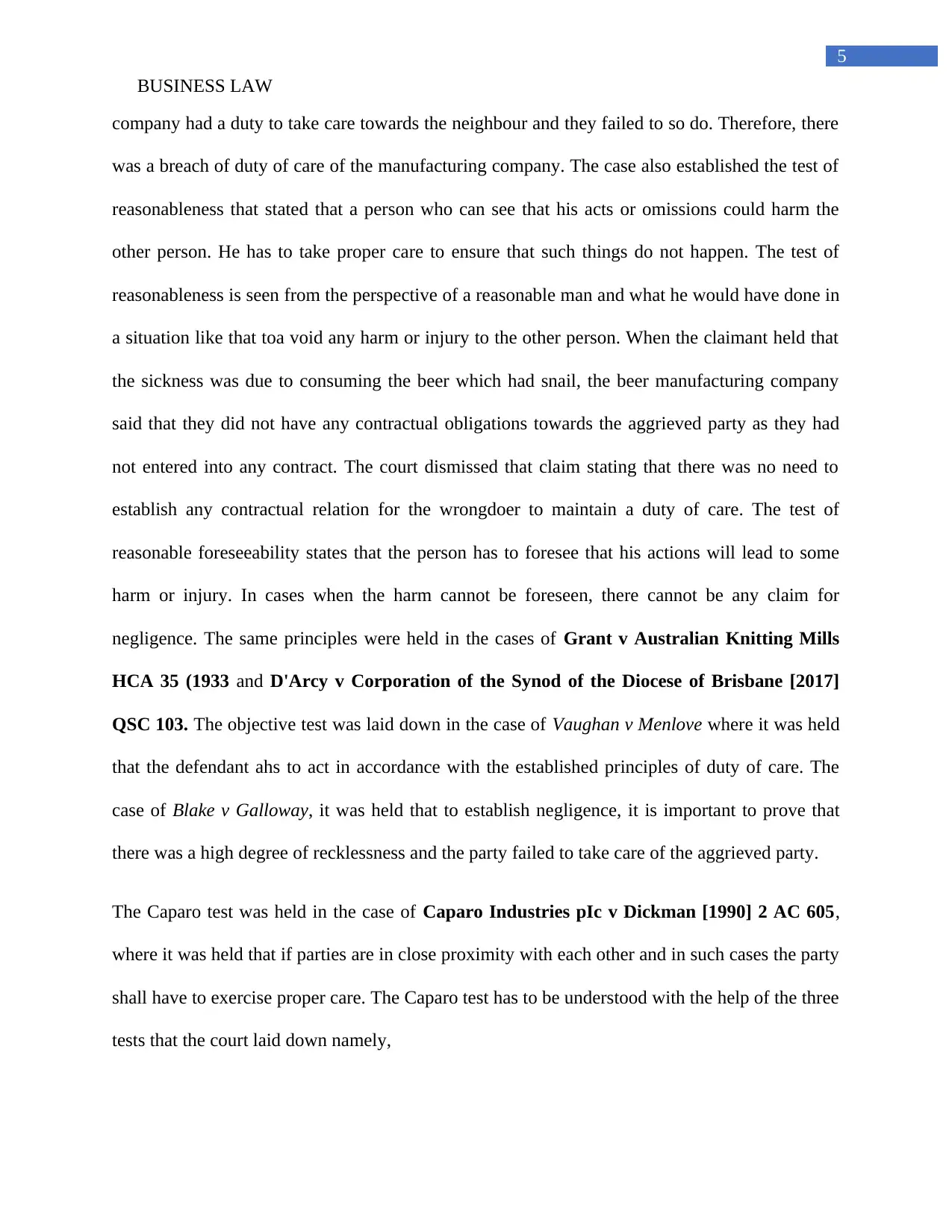
5
BUSINESS LAW
company had a duty to take care towards the neighbour and they failed to so do. Therefore, there
was a breach of duty of care of the manufacturing company. The case also established the test of
reasonableness that stated that a person who can see that his acts or omissions could harm the
other person. He has to take proper care to ensure that such things do not happen. The test of
reasonableness is seen from the perspective of a reasonable man and what he would have done in
a situation like that toa void any harm or injury to the other person. When the claimant held that
the sickness was due to consuming the beer which had snail, the beer manufacturing company
said that they did not have any contractual obligations towards the aggrieved party as they had
not entered into any contract. The court dismissed that claim stating that there was no need to
establish any contractual relation for the wrongdoer to maintain a duty of care. The test of
reasonable foreseeability states that the person has to foresee that his actions will lead to some
harm or injury. In cases when the harm cannot be foreseen, there cannot be any claim for
negligence. The same principles were held in the cases of Grant v Australian Knitting Mills
HCA 35 (1933 and D'Arcy v Corporation of the Synod of the Diocese of Brisbane [2017]
QSC 103. The objective test was laid down in the case of Vaughan v Menlove where it was held
that the defendant ahs to act in accordance with the established principles of duty of care. The
case of Blake v Galloway, it was held that to establish negligence, it is important to prove that
there was a high degree of recklessness and the party failed to take care of the aggrieved party.
The Caparo test was held in the case of Caparo Industries pIc v Dickman [1990] 2 AC 605,
where it was held that if parties are in close proximity with each other and in such cases the party
shall have to exercise proper care. The Caparo test has to be understood with the help of the three
tests that the court laid down namely,
BUSINESS LAW
company had a duty to take care towards the neighbour and they failed to so do. Therefore, there
was a breach of duty of care of the manufacturing company. The case also established the test of
reasonableness that stated that a person who can see that his acts or omissions could harm the
other person. He has to take proper care to ensure that such things do not happen. The test of
reasonableness is seen from the perspective of a reasonable man and what he would have done in
a situation like that toa void any harm or injury to the other person. When the claimant held that
the sickness was due to consuming the beer which had snail, the beer manufacturing company
said that they did not have any contractual obligations towards the aggrieved party as they had
not entered into any contract. The court dismissed that claim stating that there was no need to
establish any contractual relation for the wrongdoer to maintain a duty of care. The test of
reasonable foreseeability states that the person has to foresee that his actions will lead to some
harm or injury. In cases when the harm cannot be foreseen, there cannot be any claim for
negligence. The same principles were held in the cases of Grant v Australian Knitting Mills
HCA 35 (1933 and D'Arcy v Corporation of the Synod of the Diocese of Brisbane [2017]
QSC 103. The objective test was laid down in the case of Vaughan v Menlove where it was held
that the defendant ahs to act in accordance with the established principles of duty of care. The
case of Blake v Galloway, it was held that to establish negligence, it is important to prove that
there was a high degree of recklessness and the party failed to take care of the aggrieved party.
The Caparo test was held in the case of Caparo Industries pIc v Dickman [1990] 2 AC 605,
where it was held that if parties are in close proximity with each other and in such cases the party
shall have to exercise proper care. The Caparo test has to be understood with the help of the three
tests that the court laid down namely,
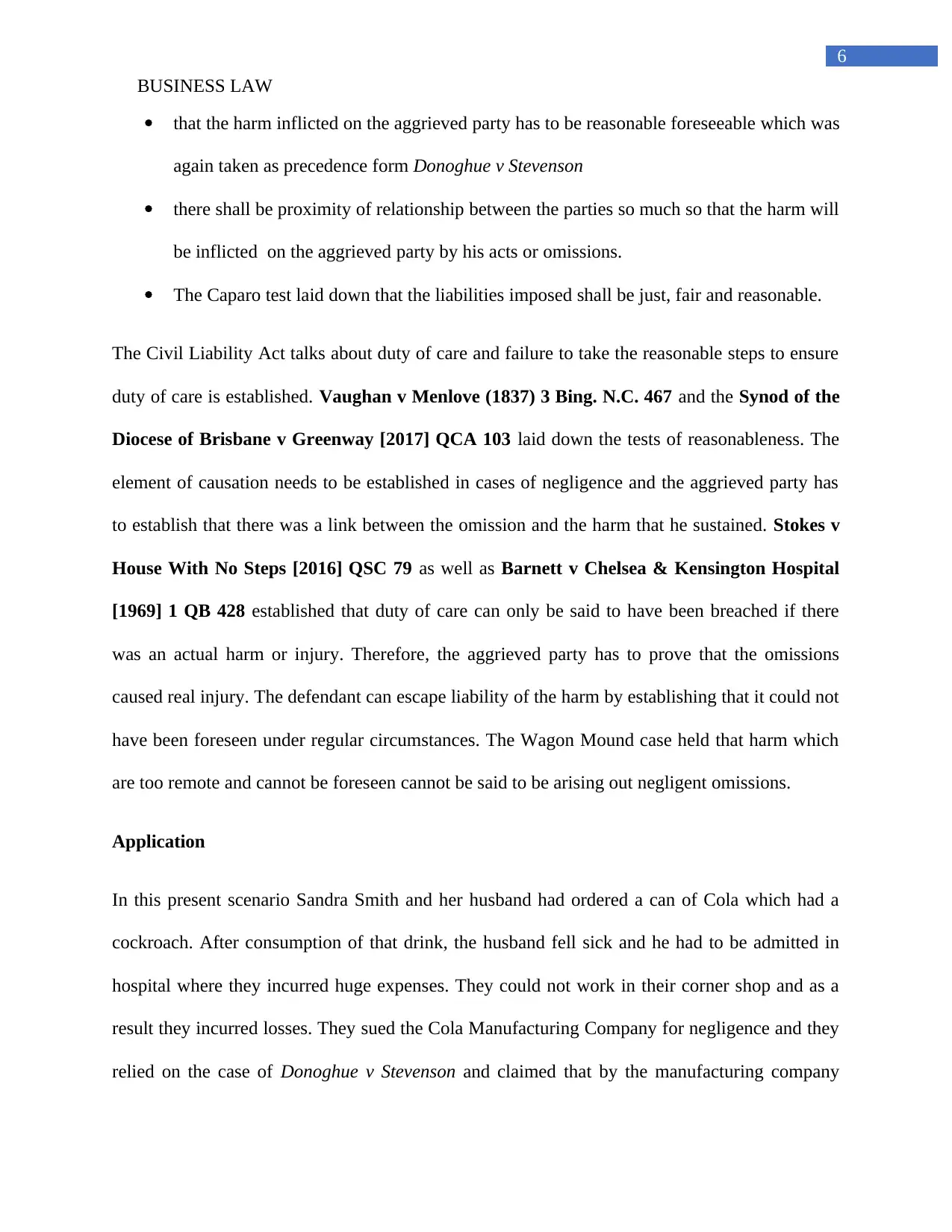
6
BUSINESS LAW
that the harm inflicted on the aggrieved party has to be reasonable foreseeable which was
again taken as precedence form Donoghue v Stevenson
there shall be proximity of relationship between the parties so much so that the harm will
be inflicted on the aggrieved party by his acts or omissions.
The Caparo test laid down that the liabilities imposed shall be just, fair and reasonable.
The Civil Liability Act talks about duty of care and failure to take the reasonable steps to ensure
duty of care is established. Vaughan v Menlove (1837) 3 Bing. N.C. 467 and the Synod of the
Diocese of Brisbane v Greenway [2017] QCA 103 laid down the tests of reasonableness. The
element of causation needs to be established in cases of negligence and the aggrieved party has
to establish that there was a link between the omission and the harm that he sustained. Stokes v
House With No Steps [2016] QSC 79 as well as Barnett v Chelsea & Kensington Hospital
[1969] 1 QB 428 established that duty of care can only be said to have been breached if there
was an actual harm or injury. Therefore, the aggrieved party has to prove that the omissions
caused real injury. The defendant can escape liability of the harm by establishing that it could not
have been foreseen under regular circumstances. The Wagon Mound case held that harm which
are too remote and cannot be foreseen cannot be said to be arising out negligent omissions.
Application
In this present scenario Sandra Smith and her husband had ordered a can of Cola which had a
cockroach. After consumption of that drink, the husband fell sick and he had to be admitted in
hospital where they incurred huge expenses. They could not work in their corner shop and as a
result they incurred losses. They sued the Cola Manufacturing Company for negligence and they
relied on the case of Donoghue v Stevenson and claimed that by the manufacturing company
BUSINESS LAW
that the harm inflicted on the aggrieved party has to be reasonable foreseeable which was
again taken as precedence form Donoghue v Stevenson
there shall be proximity of relationship between the parties so much so that the harm will
be inflicted on the aggrieved party by his acts or omissions.
The Caparo test laid down that the liabilities imposed shall be just, fair and reasonable.
The Civil Liability Act talks about duty of care and failure to take the reasonable steps to ensure
duty of care is established. Vaughan v Menlove (1837) 3 Bing. N.C. 467 and the Synod of the
Diocese of Brisbane v Greenway [2017] QCA 103 laid down the tests of reasonableness. The
element of causation needs to be established in cases of negligence and the aggrieved party has
to establish that there was a link between the omission and the harm that he sustained. Stokes v
House With No Steps [2016] QSC 79 as well as Barnett v Chelsea & Kensington Hospital
[1969] 1 QB 428 established that duty of care can only be said to have been breached if there
was an actual harm or injury. Therefore, the aggrieved party has to prove that the omissions
caused real injury. The defendant can escape liability of the harm by establishing that it could not
have been foreseen under regular circumstances. The Wagon Mound case held that harm which
are too remote and cannot be foreseen cannot be said to be arising out negligent omissions.
Application
In this present scenario Sandra Smith and her husband had ordered a can of Cola which had a
cockroach. After consumption of that drink, the husband fell sick and he had to be admitted in
hospital where they incurred huge expenses. They could not work in their corner shop and as a
result they incurred losses. They sued the Cola Manufacturing Company for negligence and they
relied on the case of Donoghue v Stevenson and claimed that by the manufacturing company
Paraphrase This Document
Need a fresh take? Get an instant paraphrase of this document with our AI Paraphraser
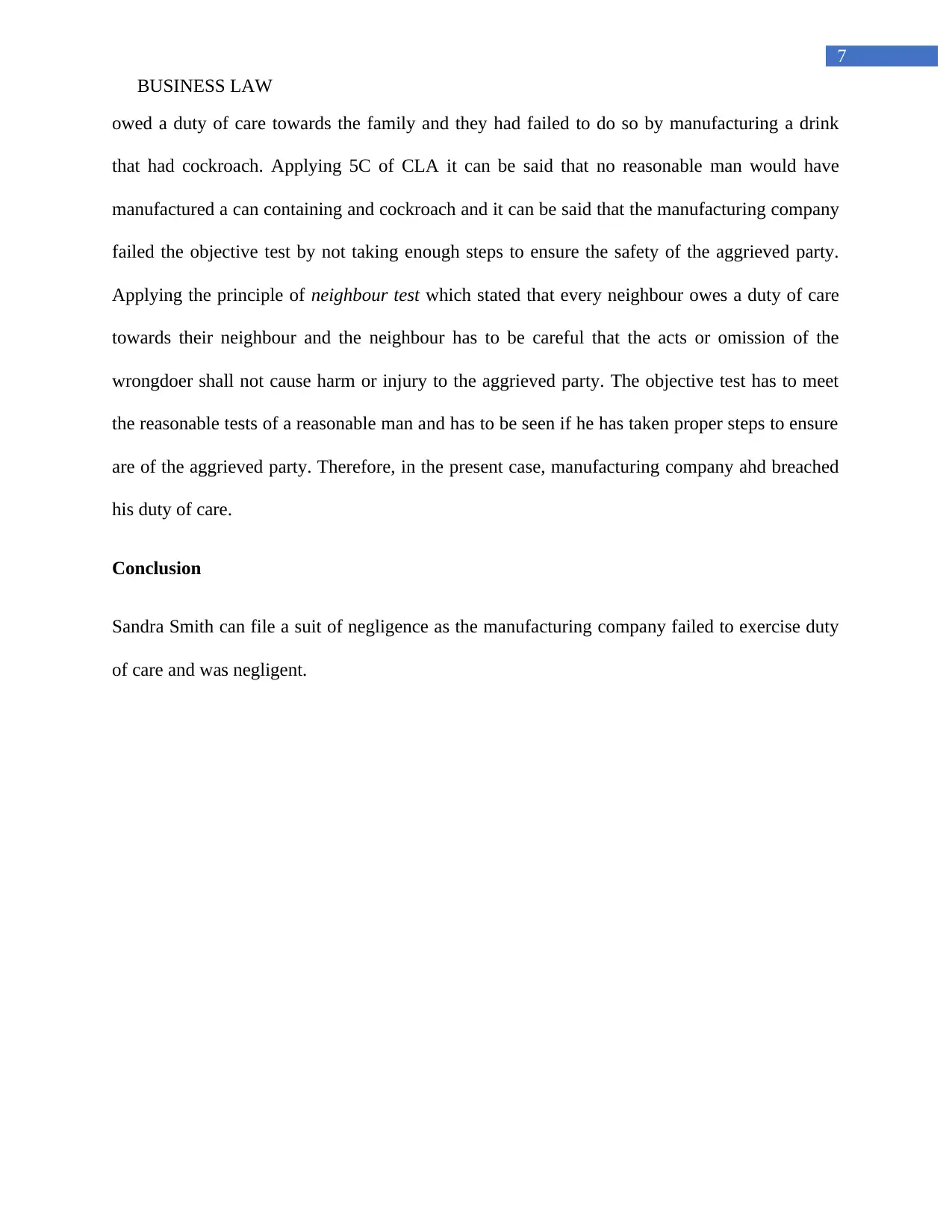
7
BUSINESS LAW
owed a duty of care towards the family and they had failed to do so by manufacturing a drink
that had cockroach. Applying 5C of CLA it can be said that no reasonable man would have
manufactured a can containing and cockroach and it can be said that the manufacturing company
failed the objective test by not taking enough steps to ensure the safety of the aggrieved party.
Applying the principle of neighbour test which stated that every neighbour owes a duty of care
towards their neighbour and the neighbour has to be careful that the acts or omission of the
wrongdoer shall not cause harm or injury to the aggrieved party. The objective test has to meet
the reasonable tests of a reasonable man and has to be seen if he has taken proper steps to ensure
are of the aggrieved party. Therefore, in the present case, manufacturing company ahd breached
his duty of care.
Conclusion
Sandra Smith can file a suit of negligence as the manufacturing company failed to exercise duty
of care and was negligent.
BUSINESS LAW
owed a duty of care towards the family and they had failed to do so by manufacturing a drink
that had cockroach. Applying 5C of CLA it can be said that no reasonable man would have
manufactured a can containing and cockroach and it can be said that the manufacturing company
failed the objective test by not taking enough steps to ensure the safety of the aggrieved party.
Applying the principle of neighbour test which stated that every neighbour owes a duty of care
towards their neighbour and the neighbour has to be careful that the acts or omission of the
wrongdoer shall not cause harm or injury to the aggrieved party. The objective test has to meet
the reasonable tests of a reasonable man and has to be seen if he has taken proper steps to ensure
are of the aggrieved party. Therefore, in the present case, manufacturing company ahd breached
his duty of care.
Conclusion
Sandra Smith can file a suit of negligence as the manufacturing company failed to exercise duty
of care and was negligent.
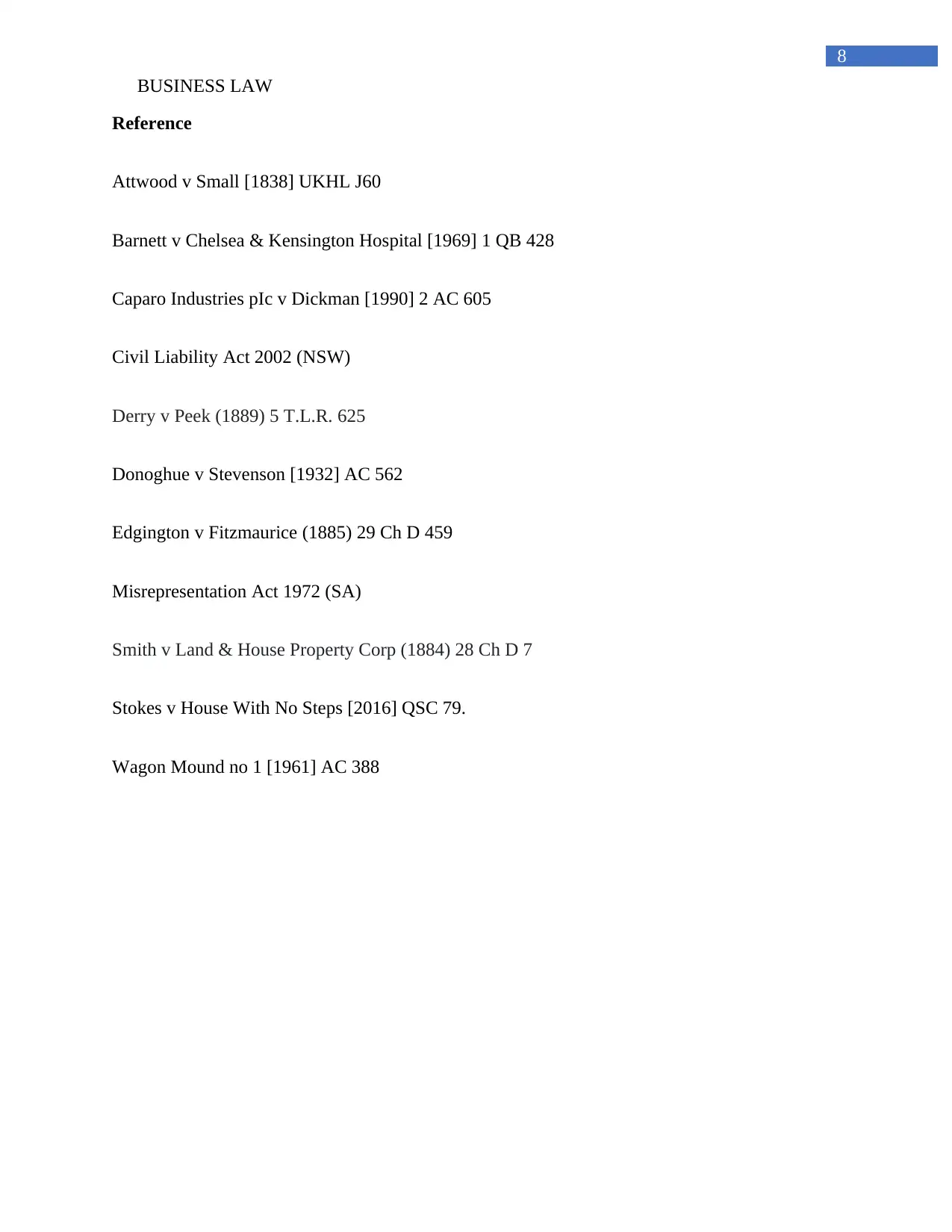
8
BUSINESS LAW
Reference
Attwood v Small [1838] UKHL J60
Barnett v Chelsea & Kensington Hospital [1969] 1 QB 428
Caparo Industries pIc v Dickman [1990] 2 AC 605
Civil Liability Act 2002 (NSW)
Derry v Peek (1889) 5 T.L.R. 625
Donoghue v Stevenson [1932] AC 562
Edgington v Fitzmaurice (1885) 29 Ch D 459
Misrepresentation Act 1972 (SA)
Smith v Land & House Property Corp (1884) 28 Ch D 7
Stokes v House With No Steps [2016] QSC 79.
Wagon Mound no 1 [1961] AC 388
BUSINESS LAW
Reference
Attwood v Small [1838] UKHL J60
Barnett v Chelsea & Kensington Hospital [1969] 1 QB 428
Caparo Industries pIc v Dickman [1990] 2 AC 605
Civil Liability Act 2002 (NSW)
Derry v Peek (1889) 5 T.L.R. 625
Donoghue v Stevenson [1932] AC 562
Edgington v Fitzmaurice (1885) 29 Ch D 459
Misrepresentation Act 1972 (SA)
Smith v Land & House Property Corp (1884) 28 Ch D 7
Stokes v House With No Steps [2016] QSC 79.
Wagon Mound no 1 [1961] AC 388
1 out of 9
Related Documents
Your All-in-One AI-Powered Toolkit for Academic Success.
+13062052269
info@desklib.com
Available 24*7 on WhatsApp / Email
![[object Object]](/_next/static/media/star-bottom.7253800d.svg)
Unlock your academic potential
© 2024 | Zucol Services PVT LTD | All rights reserved.





